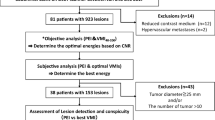Abstract
This study compared different acquisition protocols performance to detect small liver metastases (<2 cm). Thirty consecutive patients with histologically proven hepatic metastases were explored by MDCT at the liver equilibrium phase by four successive acquisitions. We compared the following protocols (1–4): 5/30/1.5 (section thickness/table speed/pitch); 5/15/0.75; 5/11.25/0.75; and 2.5/15/1.5 with the same X-ray dose. The gold standard was based on patient radiological follow-up. Evolutive lesions were considered as true positive (TP). The described lesions, not found on the follow-up exams despite tumoral progression, were considered as false positive (FP). Stable lesions could not be considered as metastasis and were eliminated. One hundred and seventy-six lesions were detected: 61 TP and 91 FP. Twenty-four lesions were eliminated. The mean kappa values for protocols 1, 2, 3 and 4 were, respectively, 0.43, 0.68, 0.73 and 0.51 (0.61–0.80: substantial agreement) and the mean areas under the ROC curve were, respectively, 0.76, 0.87, 0.86 and 0.80. The results of protocols 2 and 3 were significantly superior to those of protocols 1 and 4. MDCT protocols using thin sections or an increased table speed are less efficient in detecting small metastases.


Similar content being viewed by others
References
Roos JE, Desbiolles LM, Willmann JK, Weishaupt D, Marincek B, Hilfiker PR (2002) Multidetector-row helical CT: analysis of time management and workflow. Eur Radiol 12:680–685
Sugarbaker PH (1990) Surgical decision making for large bowel cancer metastatic to the liver. Radiology 174:621–626
Nakamura S, Suzuki S, Baba S (1997) Resection of liver metastases of colorectal carcinoma. World J Surg 21:741–747
Prokop M (2003) Multislice CT: technical principles and future trends. Eur Radiol Suppl 5:M3–M13
Itoh S, Ikeda M, Achiwa M, Ota T, Satake H, Ishigaki T (2003) Multiphase contrast-enhanced CT of the liver with a multislice CT scanner. Eur Radiol 13:1085–1094
Valls C, Andia E, Sanchez A et al. (2001) Hepatic metastases from colorectal cancer: preoperative detection and assessment of resectability with helical CT. Radiology 218:55–60
Schmidt J, Strotzer M, Fraunhofer S, Boedeker H, Zirngibl H (2000) Intraoperative ultrasonography versus helical computed tomography and computed tomography with arterioportography in diagnosing colorectal liver metastases: lesion-by-lesion analysis. World J Surg 24:43–47
Kuszyk BS, Bluemke DA, Urban BA et al. (1996) Portal-phase contrast-enhanced helical CT for the detection of malignant hepatic tumors: sensitivity based on comparison with intraoperative and pathologic findings. Am J Roentgenol 166:91–95
Fleischmann D (2003) Use of high-concentration contrast media in multiple-detector-row CT: principles and rationale. Eur Radiol Suppl 5:M14–M20
Schoellnast H, Tillich M (2004) Improvement of parenchymal and vascular enhancement using saline flush and power injection for multiple-detector-row abdominal CT. Eur Radiol 14:659–664
Verdun FR, Denys A, Valley JF, Schnyder P, Meuli RA (2002) Detection of low-contrast objects: experimental comparison of single- and multi-detector row CT with a phantom. Radiology 223:426–431
Therasse P, Arbuck SG, Eisenhauer EA et al. (2000) New guidelines to evaluate the response to treatment in solid tumors. European Organization for Research and Treatment of Cancer, National Cancer Institute of the United States, National Cancer Institute of Canada. J Natl Cancer Inst 92:205–216
Jones E, Chezmar J, Nelson R, Bernardino M (1992) The frequency and significance of small (less than or equal to 15 mm) hepatic lesions detected by CT. Am J Roentgenol 158:535–539
Schwartz LH, Gandras EJ, Colangelo SM, Ercolani MC, Panice DM (1999) Prevalence and importance of small hepatic lesions found at CT in patients with cancer. Radiology 210:71–74
Valette PJ, Pilleul F, Crombe-Ternamian A (2003) MDCT of benign liver tumors and metastases. Eur Radiol Suppl 5:M31–M41
Marchiano A (2003) MDCT of primary liver malignancies. Eur Radiol Suppl 5:M26–M30
Commission of the European Communities (2000) European guidelines on quality criteria for computed tomography. EUR 16262 EN Luxembourg, Belgium: European Communities
Kalra MK, Maher MM, Saini S (2003) Multislice CT: update on radiation and screening. Eur Radiol 13:M129–M133
Verdun FR, Lepori D, Monnin P, Valley JF, Schnyder P, Gudinchet F (2004) Management of patient dose and image noise in routine pediatric CT abdominal examinations. Eur Radiol 14 835–841
Hormann M, Philipp MO, Eberl H et al. (2004) The effect of varying low-dose protocols on perceived image quality in multidetector CT in a rabbit model of acute appendicitis. Eur Radiol 14:1465–1471
Greess H, Lutze J, Nomayr A et al. (2004) Dose reduction in subsecond multislice spiral CT examination of children by online tube current modulation. Eur Radiol 14:995–999
Hu H, He HD, Foley WD, Fox SH (2000) Four multidetector-row helical CT: image quality and volume coverage speed. Radiology 215:55–62
Fox SH, Toth T (2002) Dose reduction on GE CT scanners. Pediatr Radiol 32:718–723
Weg N, Scheer MR, Gabor MP (1998) Liver lesions: improved detection with dual-detector-array CT and routine 2.5-mm thin collimation. Radiology 209:417–426
McCollough CH, Zink FE (1999) Performance evaluation of a multi-slice CT system. Med Phys 26:2223–2230
Haider MA, Amitai MM, Rappaport DC (2002) Multi-detector row helical CT in preoperative assessment of small (< or =1.5 cm) liver metastases: is thinner collimation better? Radiology 225:137–142
Polacin A, Kalender WA, Marchal G (1992) Evaluation of section sensitivity profiles and image noise in spiral CT. Radiology 185:29–35
Wilting JE, Timmer J (1999) Artefacts in spiral-CT images and their relation to pitch and subject morphology. Eur Radiol 9:316–322
Fleischmann D, Rubin GD, Paik DS et al. (2000) Stair-step artifacts with single versus multiple detector-row helical CT. Radiology 216:185–196
Acknowledgements
This article is dedicated to the memory of Yasmine Abdelmoumene MD.
Author information
Authors and Affiliations
Corresponding author
Rights and permissions
About this article
Cite this article
Abdelmoumene, A., Chevallier, P., Chalaron, M. et al. Detection of liver metastases under 2 cm: comparison of different acquisition protocols in four row multidetector-CT (MDCT). Eur Radiol 15, 1881–1887 (2005). https://doi.org/10.1007/s00330-005-2741-x
Received:
Revised:
Accepted:
Published:
Issue Date:
DOI: https://doi.org/10.1007/s00330-005-2741-x




